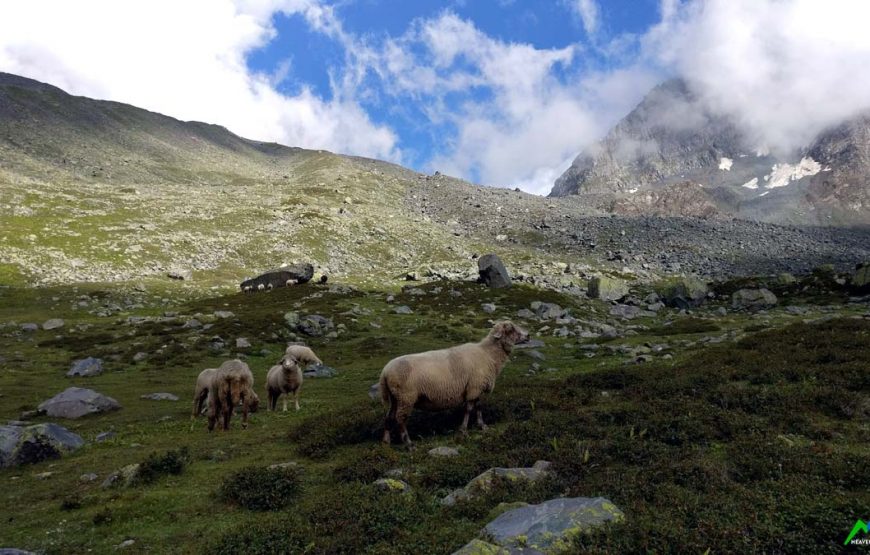Nestled 26 kilometers from Bharmour in the enchanting Budhil valley, the Manimahesh Lake stands as a beacon of spiritual serenity in the lap of the Himalayas. This sacred waterbody, situated at a breathtaking altitude of 13,000 feet, rests at the foot of the majestic Kailash peak, towering at 18,564 feet. This revered pilgrimage site in Himachal Pradesh attracts thousands of devotees annually, particularly during the fair held on the eighth day of the light half of the moon in the month of Bhadon.
The divine aura of Manimahesh is centered around Lord Shiva, the presiding deity of the fair. Local lore has it that Lord Shiva resides in Kailash, and a distinctive rock formation in the shape of a Shivling on Kailash is believed to be the divine manifestation of the Lord. The snowfield at the mountain’s base is lovingly referred to as Shiva’s Chaugan by the locals.
Mount Kailash itself is deemed invincible; no human has successfully scaled its peaks, despite other taller mountains, like Everest, being conquered numerous times. Legend has it that a Gaddi (shepherd) who attempted to climb the mountain with his flock was turned into stone, along with his sheep. The series of minor peaks below Kailash are said to be the remnants of this ill-fated shepherd and his herd.
Another intriguing legend speaks of a snake’s failed attempt to climb Kailash, resulting in its transformation into stone. Devotees believe that a clear view of the Kailash peak is only granted when Lord Shiva is pleased, and obscured by clouds during bad weather indicates the Lord’s displeasure.
At the corner of Manimahesh Lake stands a marble image of Shiva, worshipped fervently by pilgrims. After taking a holy dip in the lake’s tranquil waters, devotees perform a circumambulation of the lake three times, immersing themselves in the majestic scenery. The quiet waters of the lake mirror the snow-capped peaks, creating a breathtaking panorama.
Pilgrims approaching Manimahesh can take different routes. Those from Lahaul-Spiti traverse the challenging Kugti pass, while others from Kangra and Mandi come via Kawarsi or Jalsu passes. The most accessible route begins in Chamba, passing through Bharmour. Buses ply up to Hadsar, beyond which pilgrims embark on a 13-kilometer trek to reach Manimahesh. Dhanchho, an essential stop between Hadsar and Manimahesh, offers pilgrims a tranquil night’s stay, accompanied by the melody of a beautiful waterfall.
Just 1.5 kilometers shy of Manimahesh Lake lie two significant water bodies, Gauri Kund and Shiva Krotri. Devotees believe that Gauri and Shiva bathe in these waters respectively. Women pilgrims take a holy dip in Gauri Kund, while men immerse themselves in Shiva Krotri before proceeding to the sacred Manimahesh Lake.
The journey to Manimahesh is not just a physical pilgrimage but a spiritual odyssey, inviting seekers to connect with the divine in the heart of the Himalayas. The legends, the rituals, and the breathtaking landscape converge to make Manimahesh a haven for spiritual exploration and transcendence.The Manimahesh Yatra is a special trip that many people take to a holy place in the mountains. People believe that going to this place and taking a dip in the lake there can make them feel closer to God and wash away their mistakes. It’s not just for religious folks but also for those who love adventure.
Why Manimahesh is Important:
According to stories, the Manimahesh Lake is where Lord Shiva lives. Long ago, Lord Shiva did special prayers here, making it a very important spot for people who follow Hinduism. The lake reflects a big mountain called Kailash, making it even more special.
Getting Ready for the Journey:
Picking the Right Time:
The Manimahesh Yatra usually happens in July or August, a time considered lucky. Before going, it’s important to check the weather and if the way to the lake is open and safe.
 How to Get There:
How to Get There:
The journey starts from a small town called Bharmour. From there, people walk about 14 kilometers to reach the special lake. Along the way, they see beautiful mountains covered in snow, green fields, and waterfalls.
Where to Stay:
Planning where to stay is important. Bharmour has places where people can stay, and there are also temporary camps along the way for those who want a different experience.
The Walk to Manimahesh Lake:
The Special Journey:
As people walk to the lake, they feel the magic of the mountains. They see colorful flags and hear chanting, creating a special feeling of devotion.
Nature’s Beauty on the Way:
The journey is not just about religion; it’s also a chance to enjoy nature. The path goes through forests, flowery meadows, and streams. The big snowy mountains remind everyone of something divine.
Doing Special Things at the Lake:
Taking a Dip:
When people reach Manimahesh Lake, they take a special bath in its clean water. This is thought to clean the soul and make the mind pure. People pray and ask for blessings from Lord Shiva for wisdom and peace.
Worshipping at the Temple:
There’s a temple near the lake where people do ceremonies and offer prayers. The air is filled with the smell of incense, and everyone feels connected to something bigger. People give flowers, sweets, and other things to show their thanks.
Challenges and Being Safe:
Altitude Sickness:
Because the place is very high, some people might feel sick. It’s important to get used to the height slowly and drink lots of water. Seeing a doctor before going is a good idea.
Weather Changes:
The weather in the mountains can be surprising. Sometimes it rains or snows suddenly, making the way difficult. Watching the weather and wearing the right clothes are important for a safe journey.
Being Safe on the Way:
Sticking to the path, not taking shortcuts, and carrying necessary things like a first aid kit and snacks are important for safety. Going at a moderate pace and not tiring yourself too much makes the journey more enjoyable.
Seeing More Around Manimahesh:
Exploring Chamba Valley:
After the yatra, people can visit the beautiful Chamba Valley. There are old temples, palaces, and markets to see. It’s a chance to learn about the history and culture of the place.
Visiting Bharmour:
The journey starts from Bharmour, and it has its own interesting spots. There are ancient temples, and the Chaurasi Temple complex has 84 shrines. Bharmour is also a starting point for different trekking trails.
Conclusion:
The Manimahesh Yatra is a special journey to a holy lake in the Himalayas, believed to be Lord Shiva’s abode. Pilgrims trek from Bharmour, about 14 kilometers, through scenic landscapes. The journey is a mix of spirituality and adventure, with rituals like bathing in the lake and worship at the Manimahesh Temple. Challenges include altitude sickness and unpredictable weather. After the pilgrimage, explorations in the Chamba Valley and Bharmour reveal ancient temples and cultural heritage. The Yatra leaves pilgrims with a sense of peace and cherished memories.






Comment (0)